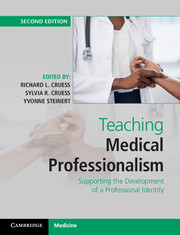Book contents
- Frontmatter
- Contents
- List of contributors
- Foreword
- Introduction
- Part I What is to be taught and learned
- 1 Professionalism and professional identity formation: the cognitive base
- 2 Developing a professional identity: a learner's perspective
- Part II Theory
- Part III Principles
- Part IV Case studies in promoting professionalism and professional identity formation across the continuum
- Part V The future
- Index
- References
1 - Professionalism and professional identity formation: the cognitive base
from Part I - What is to be taught and learned
Published online by Cambridge University Press: 05 April 2016
- Frontmatter
- Contents
- List of contributors
- Foreword
- Introduction
- Part I What is to be taught and learned
- 1 Professionalism and professional identity formation: the cognitive base
- 2 Developing a professional identity: a learner's perspective
- Part II Theory
- Part III Principles
- Part IV Case studies in promoting professionalism and professional identity formation across the continuum
- Part V The future
- Index
- References
Summary
The task of medical education is to “shape the novice into the effective practitioner of medicine, to give him the best available knowledge and skills, and to provide him with a professional identity so that he comes to think, act, and feel like a physician.”1 (p. 5)
During the past few decades, it has become apparent that the issue of the professionalism of individual physicians and of the medical profession must be addressed explicitly at all levels of medical education. For this reason, the subjects of professionalism and professional identity are being addressed directly throughout the continuum of medical education.2–10 As is true of any significant topic that must be learned, there is a defined body of knowledge called the cognitive base that serves as the basis of the teaching, learning, and assessment of the subject. The purpose of this chapter is to outline the cognitive base that should underpin educational activities designed to support learners in medicine as they become professionals and acquire their professional identities.
As physicians, patients, and members of the general public have come to believe that medicine's professionalism is under threat, virtually all have concluded that any action to address the issue must include major initiatives throughout medical education aimed at ensuring that physicians both understand the nature of contemporary medical professionalism and live according to its precepts – that they come to “think, act, and feel like a physician.”1–6 As a result, there is now a substantial literature describing how this can best be accomplished, with a recent shift in emphasis toward supporting professional identity formation.
For centuries, professionalism as a subject was not addressed directly. There were no courses on professionalism and it was not included in the standard medical curriculum. This is not because it was deemed unimportant. The Hippocratic Oath, subsequent codes of ethics, and a host of writers addressed the values and beliefs of the medical profession, often linking them to the word “professionalism.” However, it was assumed that these values and beliefs that are the foundation of the profession would be automatically acquired during the educational process as students “acquire the complex ensemble of analytic thinking, skillful practice, and wise judgment.”
- Type
- Chapter
- Information
- Teaching Medical ProfessionalismSupporting the Development of a Professional Identity, pp. 5 - 25Publisher: Cambridge University PressPrint publication year: 2016
References
- 13
- Cited by



